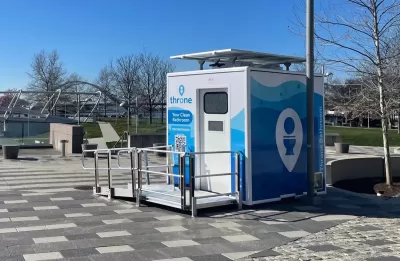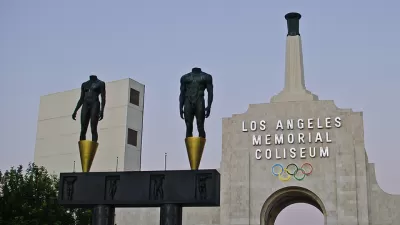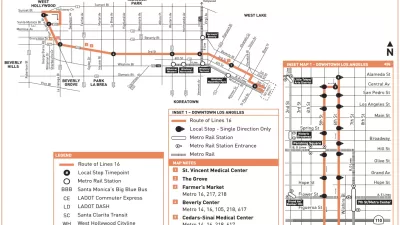The city’s transit stations are notoriously devoid of restrooms, shade, and other amenities while riders face long waits.

In response to consistent complaints about the lack of restroom facilities at Los Angeles public transit stations, a six-month pilot program in Los Angeles is “testing three portable, self-contained bathroom units last week at Metro's busiest train stations: Westlake/MacArthur Park on the B (Red)/D (Purple) Lines; Willowbrook/ Rosa Parks on the A (Blue)/C (Green) Lines; and the Norwalk station on the C Line.” Steve Scauzillo of The Whittier Daily News reports on the story in an article published in Mass Transit.
The program was proposed by Throne, a Washington, D.C.-based portable bathroom producer whose system “only allows access via a cell phone to unlock the door. And there's a 10-minute time limit on using the facility.” This will presumably bar people without access to cell phones.
As Scauzillo points out and Planetizen covered previously, “The shortage of public restrooms in the United States is acute. According to the Public Restroom Index, the U.S. has eight per 100,000 people. That is tied with Botswana.”
Transit agencies cite “cost and misuse” as top reasons for not providing bathrooms. According to Throne co-founder Jessica Heizelman, “Throne gets around the cost of hooking pipes to water and sewer lines by making its bathrooms self-contained. They have their own water and sewer tanks. And power comes from solar panels.”
According to Metro’s The Source, “Toilets will generally be open 6 a.m. to 9 p.m. seven days a week.” Metro adds, “We expect to learn much from the pilot, specifically how the public toilets perform, the demand for them and public acceptance. The findings will help guide us when it comes to public restrooms in the future.”
FULL STORY: CA: Toilets at LA Metro train and bus stations are very rare, but four are being tested at busy stops

Planetizen Federal Action Tracker
A weekly monitor of how Trump’s orders and actions are impacting planners and planning in America.

Chicago’s Ghost Rails
Just beneath the surface of the modern city lie the remnants of its expansive early 20th-century streetcar system.

San Antonio and Austin are Fusing Into one Massive Megaregion
The region spanning the two central Texas cities is growing fast, posing challenges for local infrastructure and water supplies.

Since Zion's Shuttles Went Electric “The Smog is Gone”
Visitors to Zion National Park can enjoy the canyon via the nation’s first fully electric park shuttle system.

Trump Distributing DOT Safety Funds at 1/10 Rate of Biden
Funds for Safe Streets and other transportation safety and equity programs are being held up by administrative reviews and conflicts with the Trump administration’s priorities.

German Cities Subsidize Taxis for Women Amid Wave of Violence
Free or low-cost taxi rides can help women navigate cities more safely, but critics say the programs don't address the root causes of violence against women.
Urban Design for Planners 1: Software Tools
This six-course series explores essential urban design concepts using open source software and equips planners with the tools they need to participate fully in the urban design process.
Planning for Universal Design
Learn the tools for implementing Universal Design in planning regulations.
planning NEXT
Appalachian Highlands Housing Partners
Mpact (founded as Rail~Volution)
City of Camden Redevelopment Agency
City of Astoria
City of Portland
City of Laramie





























